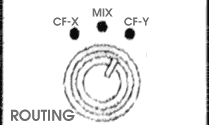Presented at the Musikmesse 2001 in Frankfurt, Rodec did a good job with the new CX-1100. Estimated time of the production for the CX-1100 shall be the the 2nd half of 2001.
Apart from the exotic and rare MX230, the new MX300 MKIII and some smallers mixers (e.g. MX7, MX100, MX120, MX126) it's the first real Rodec with factory-equipped push-buttons for the PFL controls. Nothing special for a (DJ-)mixer, but for a Rodec. Even more important it's absolutely the first Rodec with a pre-mix in the PFL section, at the fair was a little assumtion that there has been a Rodec with this feature in the past. If that is true, this mysterious mixer must be even less known than the MX230. And finally and most of all, the CX-1100 is the very first Rodec with a fully assignable crossfader section. This crossfader section is in fact the only thing on the prototype of the CX-1100 that really requires improvement:
As stated in the preface, improvements only concern the crossfader section, more exaclty they only concern the assignment switches.
The CX-1100 uses rotary switches for the crossfader assignment. This pure fact isn't a reason for a change yet. But unfortunately Rodec chose an unusal order of the three positions of each crossfader assignment switch, with the crossfader bypass position ("MIX") not in the center (Figure 1).
Figure 1: prototype design with unsuitable order (MIX CF-X CF-Y)
prototype design with unsuitable order (MIX CF-X CF-Y)
This order isn't a good idea. Although the switch and the design of the electronical circuits allow an unhearable change between no assignment to the crossfader ("MIX") and an assignment to the left side of the crossfader ("CF-X") and vice verse, there is no opportunity to do the same with the right side of the crossader ("CF-Y"). With the prototype design of the mixer the user would have to go over the "CF-X" position to change between "MIX" and "CF-Y". Any attempt to change between these two positions during the mix (the DJ's mix), will lead to a rude treatment of the control knob and the DJ is kept busy with the shortcomings of the mixer instead with the music he/she is mixing. As there is practically no need to do a straight change between "CF-X" and "CF-Y" positions, the "MIX" position can and should be located between these two positions (Figure 2).
Figure 2: improved design with usual order (CF-X MIX CF-Y)
improved design with usual order (CF-X MIX CF-Y)
Last step to even more intuitive and oparable working with the CX-1100: The writing on the front plate marking the three positions should be better located above the control knob and not aside, like at the prototype (Figure 3). The handling becomes more intuitive when the "MIX" position is located at a 12 o'clock position. In addition the writing is less covered by the users hand during operation, therefore this layout is more operable, too. "CF-X" and "CF-Y" are then left and right at the control knob and not up and down. Because the crossfader itself moves from left to right and back (and not up, down or in any other direction) it is ovbious which layout is more intuitive. A good comparison are balance or equalizer control knobs, the usually have their center or 0dB point at a 12 o'clock position, too. All other mixers with rotary controls for the crossfader assignment use this layout for a reason, even Rodec already used it for the ear dedication switches of the MX230. So hopefully the final version of the CX-1100 will use it, too.
Figure 3: more intuitive and operable design with writing above the control knob
more intuitive and operable design with writing above the control knob